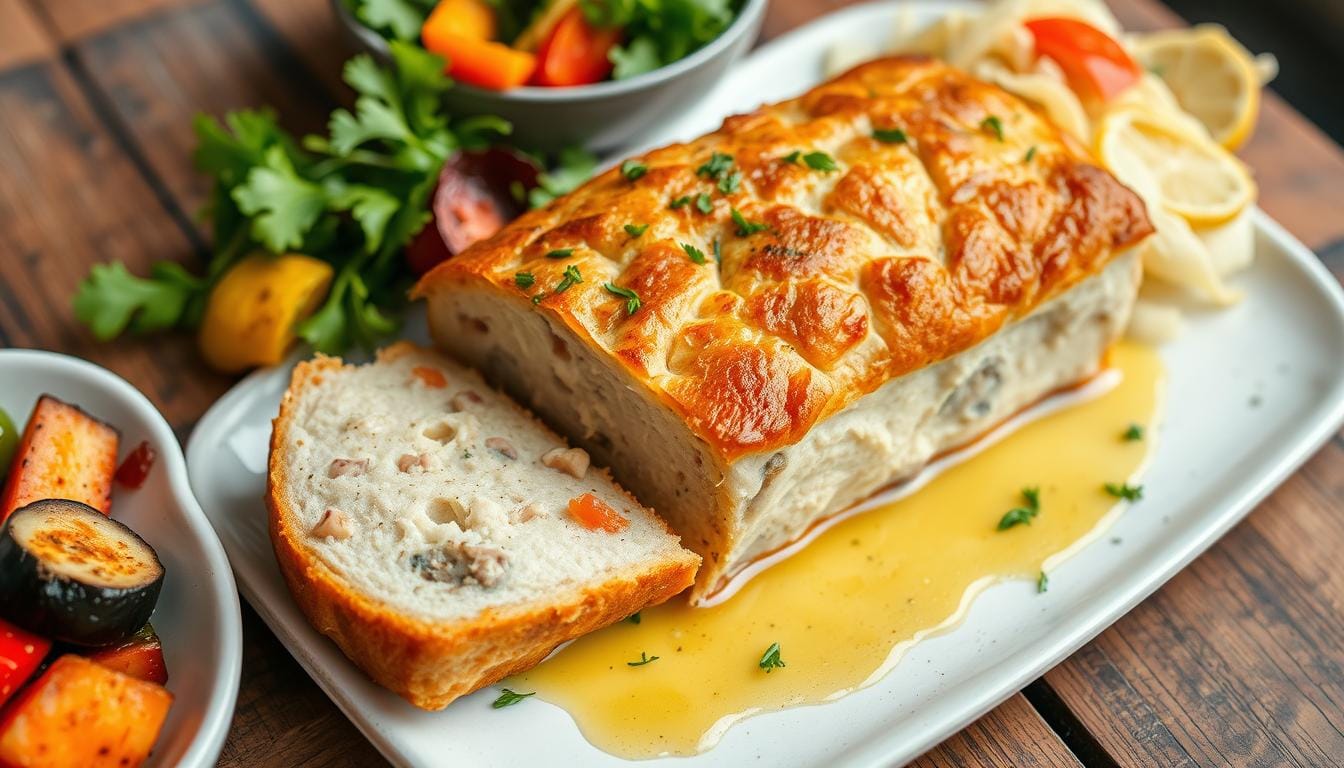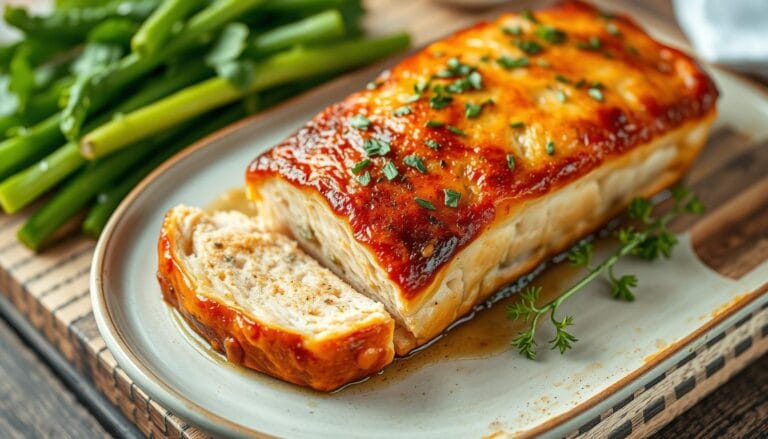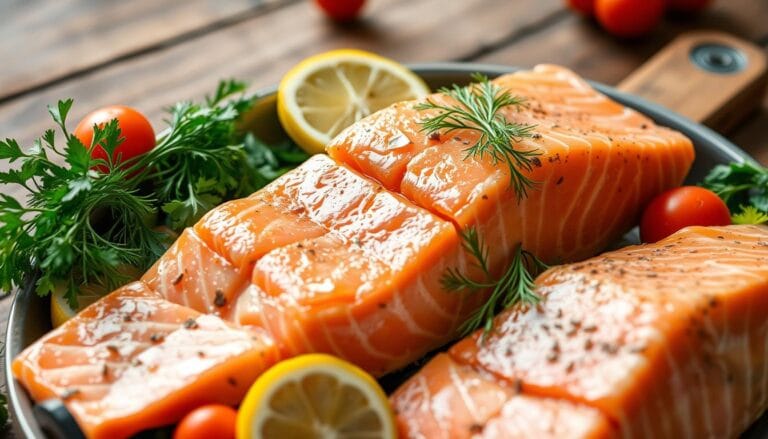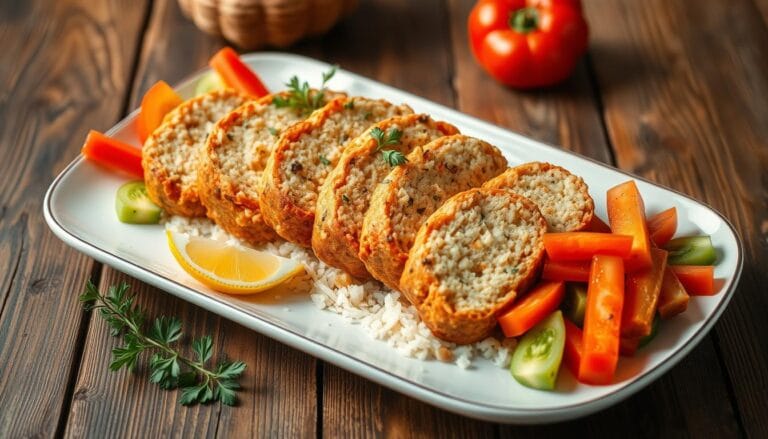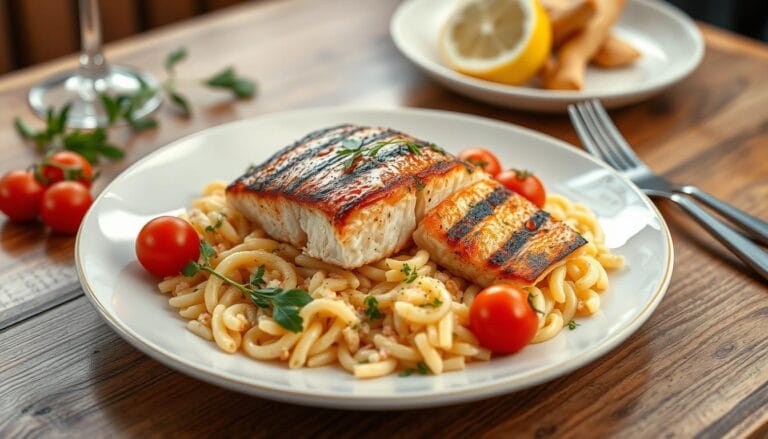can tuna and salmon be used in same loaf recipe
As a home chef, you’re always looking to improve your cooking and impress your family. You might have thought about mixing tuna and salmon in one loaf. These fish have different tastes and health benefits. But can they work well together in a dish?
Yes, they can! Mixing tuna and salmon in a loaf creates a mix of flavors and nutrients. Each fish brings something special to the table. This way, you get a dish that tastes great and is good for you.
Table of Contents
Understanding Fish Loaf Basics
Fish loaves have a rich history, starting in the Great Depression era. They were a cheap, protein-rich meal. Mixing tuna and salmon in a loaf makes them taste great and healthy.
Traditional Fish Loaf Origins
In the Great Depression, cooks made do with little. They created fish loaves to use up fish. These loaves became a common meal in many homes.
Benefits of Fish-Based Recipes
Fish loaves are not just tasty; they’re also good for you. They’re full of protein, omega-3s, and vitamins. They make for a healthy, tasty meal.
Common Misconceptions About Fish Loaves
Some think fish loaves taste bad or are hard to make. But, with the right ingredients and cooking, they’re delicious. They’re perfect for families.
Nutritional Benefits of Combining Tuna and Salmon
Tuna and salmon are top choices for protein-rich seafood. Mixing them in a loaf recipe brings together great nutrients and health perks.
Tuna packs about 23.4 grams of protein in every 3-ounce serving. Salmon has slightly less, with 19.8 grams. But salmon is a winner for omega-3 fatty acids, with 1.5 grams per serving, while tuna has only 0.1 grams.
| Nutrient | Tuna (3 oz) | Salmon (3 oz) |
|---|---|---|
| Calories | 110 | 155 |
| Protein (g) | 25 | 22 |
| Fat (g) | 0.5 | 6 |
| Omega-3 Fatty Acids (g) | 0.1 | 1.5 |
| Vitamin B-12 (mcg) | 2.4 | 3.8 |
| Vitamin D (mcg) | 2 | 14 |
| Selenium (mcg) | 92 | 36 |
| Niacin (mg) | 18 | 8.6 |
Both tuna and salmon are full of vitamins and minerals. Salmon is a vitamin D powerhouse, with 14 micrograms per serving. Tuna is rich in selenium and niacin. Mixing them in a loaf recipe gives you a dish full of nutrients.
Experts say to eat two to three fish servings a week for a healthy diet. Adding tuna and salmon to your meals helps you meet this goal. It ensures you get a variety of nutrients for your health.
Essential Ingredients for a Mixed Fish Loaf
Making a tasty fish loaf with tuna and salmon starts with the right ingredients. You’ll need canned tuna, canned salmon, breadcrumbs or crushed crackers, eggs, and milk or cream. These help bind everything together.
Core Components and Binding Agents
The base of your fish loaf is canned tuna and salmon. Breadcrumbs or crushed crackers soak up moisture and keep the loaf together. Eggs and milk or cream add richness and help bind the ingredients.
Recommended Seasonings and Herbs
To make your fish loaf even better, add some seasonings and herbs. Salt, pepper, garlic powder, parsley, and dill are great choices. You can also try lemon zest, Dijon mustard, or Parmesan cheese for extra flavor.
Optional Flavor Enhancers
For a unique twist, add diced onions, celery, or other chopped veggies. These not only add flavor but also texture. The right mix of ingredients will make a delicious fish loaf that’s sure to please.
Can Tuna and Salmon Be Used in Same Loaf Recipe
Absolutely! Mixing tuna and salmon in a loaf recipe makes a tasty and healthy dish. The firm tuna goes well with the soft salmon. This mix makes the dish more interesting to eat.
Using both tuna and salmon balances the flavors. Tuna’s mild taste balances out salmon’s stronger flavor. This mix pleases many people’s taste buds.
This mix is also very nutritious. Tuna is full of protein, and salmon has omega-3s that are good for your heart. Together, they make a meal that’s good for you.
To make a great tuna and salmon loaf, it’s important to mix the fish right. You need to blend them well and use the right amount of each. This makes the loaf taste good and feel right in your mouth.
Exploring the Versatility of Tuna and Salmon Combinations
Tuna and salmon can be used in many ways in a loaf recipe. You can try different seasonings and herbs to make it your own. This lets you make a dish that you and your family will love.
For example, you can add garlic, onion, and herbs to give it more flavor. Or, you can use lemon, dill, and capers for a Mediterranean taste. The possibilities are endless.
So, tuna and salmon in a loaf recipe is a great choice. It’s tasty, healthy, and lets you get creative in the kitchen. You can make a dish that everyone will enjoy.
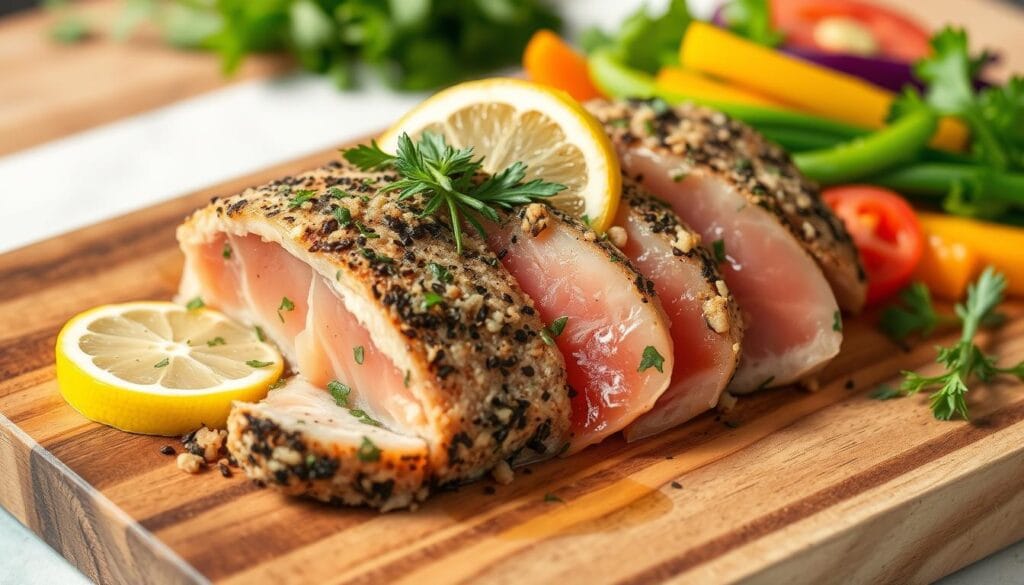
In conclusion, tuna and salmon in a loaf recipe is a smart choice. It’s healthy and lets you try new flavors. You can make a delicious mixed fish loaf that everyone will love.
Texture Considerations When Mixing Fish Types
Making a tasty fish loaf means balancing the textures of different seafood. Tuna is firm and dense, while salmon is softer and oilier. To get the right consistency, adjust the binding ingredients like breadcrumbs or eggs.
Begin with a 1:1 tuna to salmon mix. Then, adjust the mix to your liking for the perfect texture. For a lighter loaf, add panko breadcrumbs for a fluffier feel.
The goal is a fish loaf that’s moist but not too wet or dry. This balance is key for a great fish loaf texture and seafood loaf consistency. It makes for a moist and enjoyable moist fish loaf experience.
“Canned seafood provides a cost-effective way to consume healthy fats and proteins, comparable to fresh seafood.”
Managing Moisture Content
Tuna absorbs excess moisture well, while salmon adds more liquid. Adjust breadcrumbs or eggs to keep the seafood loaf consistency right. A good loaf should hold its shape but stay tender and juicy.
Achieving the Perfect Consistency
Start with a 1:1 tuna to salmon mix. Watch the texture and adjust as needed for your fish loaf texture. Aim for a moist fish loaf that’s firm but full of flavor and feel.
Step-by-Step Preparation Guide
Making a tasty tuna and salmon loaf is a fun cooking journey you can do at home. Follow this easy guide to make a delicious and healthy seafood loaf. It will wow your family and friends.
- Preheat your oven to 350°F (175°C).
- In a large mixing bowl, mix equal parts of canned tuna and salmon. Make sure to drain the liquid from the cans first.
- Add breadcrumbs, beaten eggs, finely chopped onions, and your favorite seasonings to the fish mix. Blend the ingredients together thoroughly until the mixture is well-combined.
- Grease a baking dish or loaf pan and shape the fish mix into a compact loaf, placing it in the prepared pan.
- Bake the tuna salmon loaf for 30 to 35 minutes, or until the top is lightly browned and the center is firm to the touch.
- Remove the seafood loaf from the oven and let it cool slightly before slicing and serving.
This simple method makes a delicious, healthy, and attractive how to make fish loaf. It’s perfect for any occasion, from weeknight dinners to special events.
“The key to a successful tuna salmon loaf recipe lies in the balance of the seafood and the perfect blend of seasonings. This dish is a true crowd-pleaser that celebrates the flavors of the sea.”
Best Cooking Methods and Temperature Guidelines
To make the perfect fish loaf, you need to know how to cook it right. Whether it’s tuna and salmon or seafood, getting the cooking just right is key. This ensures your dish is moist and full of flavor.
Optimal Baking Conditions
Bake your fish loaf at 350°F (175°C) for the best results. This temperature helps cook it evenly without drying it out. The baking time is usually 30 to 45 minutes, depending on the loaf’s size.
To check if it’s done, insert a knife into the center. It should come out clean. The internal temperature should be 145°F (63°C).
If the top browns too fast, cover it with foil. This prevents burning and lets the inside cook more.
Testing for Doneness
It’s important to check the internal temperature of your fish loaf. The FDA says to cook fish to 145°F (63°C) for safety. But, some fish like salmon can be cooked to 125°F (52°C) for a flakier texture.
Use a meat thermometer to check the temperature. Insert it into the thickest part of the loaf. This ensures your fish loaf is cooked just right.
“Patience and a meat thermometer are key to achieving the perfect fish loaf. Don’t be afraid to test for doneness to ensure your dish is cooked to your desired level of tenderness.”
Serving Suggestions and Accompaniments
Enjoying your tuna and salmon loaf can be a fun adventure. Start with a squeeze of lemon juice for a burst of citrus. A crisp salad or steamed veggies add a fresh touch to your meal. Roasted potatoes or fluffy rice can also add a comforting element.
Try different sauces to boost the flavor of your seafood loaf. A tangy tartar sauce, creamy dill yogurt, or lemon-butter sauce can make it even better. These flavors complement the rich taste of the loaf, making each bite special.
The tuna salmon loaf is great for any meal. It’s perfect for a family dinner or a weekend brunch. This fish loaf can be the main attraction, paired with your favorite seafood loaf serving ideas.
| Serving Suggestion | Flavor Profile | Nutritional Benefits |
|---|---|---|
| Lemon Wedges | Fresh, Citrusy | Vitamin C, Hydration |
| Mixed Green Salad | Light, Refreshing | Fiber, Antioxidants |
| Roasted Potatoes | Comforting, Starchy | Complex Carbohydrates, Potassium |
| Tartar Sauce | Tangy, Creamy | Healthy Fats, Protein |
| Dill Yogurt Sauce | Refreshing, Herbal | Probiotics, Calcium |
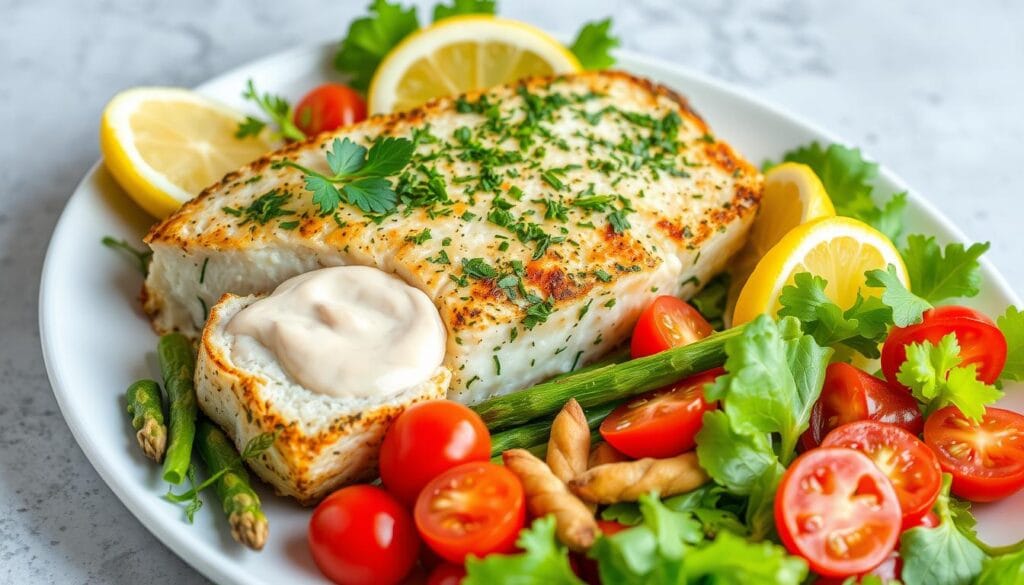
“The combination of tuna and salmon in this loaf creates a truly unique and delicious seafood experience. Paired with the right sides, it’s a meal that’s sure to impress.”
Storage and Reheating Tips
Storing and reheating your leftover tuna and salmon loaf right is key. It keeps the taste and freshness in. Store it in an airtight container in the fridge for 3-4 days. For longer storage, freeze it for up to 2 months.
Proper Storage Methods
When storing, use an airtight container or wrap it well in plastic or foil. This keeps it moist. If freezing, cool it first and wrap it tightly. Use parchment paper between layers to avoid sticking.
Safe Reheating Practices
Reheating your loaf safely is crucial. It should reach 165°F (74°C) to kill bacteria. The oven at 350°F (175°C) is best for this.
Or, microwave it in short bursts to avoid drying. Always check for spoilage before eating.
